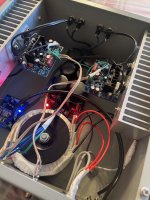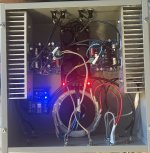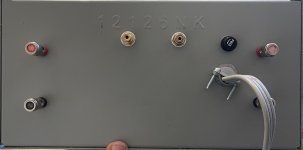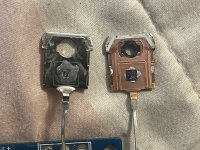https://www.amazon.com/Mugast-UPC12...38&sprefix=speaker+protection+,aps,173&sr=8-4
What you guys think of this ?
What you guys think of this ?
Its up to you, its your money 😉 I am very sceptical on these things as we see so many fakes around. Two genuine relays, genuine chip, a 7812 and all the other bits plus the board for under $10. Like I say, its up to you. It would at least be interesting to see what it was like.
DC protection relays need to have high current ratings because it is hard to break a high current circuit due to arcing. I bought 15A relays for mine.
Btw, I did buy some and test them. They do work, but I wasn’t confident enough in them to put them in my main system.
https://www.amazon.com/dp/B08HX22X8...d2lkZ2V0TmFtZT1zcF9waG9uZV9kZXRhaWwp13NParams
There is also this one it’s got 10am rated relays but they don’t look as robust to me as the first link I sent
There is also this one it’s got 10am rated relays but they don’t look as robust to me as the first link I sent
Solid state relays are the best option imo.
If (anyone) has an old woofer and you flash a battery across the speaker terminals... a 12 volt gel battery is fun but might harm the speaker... you will see just why relay contacts are generally not suited for this application. The large inductance and high current flow draws a very very large arc, more than you might ever imagine. Try a 1.5 volt battery, that won't harm any large speaker.
Look at the first 20 seconds of this. Your speakers smaller coil will spark and arc just as much because of the high inductance of the magnetic core:
If (anyone) has an old woofer and you flash a battery across the speaker terminals... a 12 volt gel battery is fun but might harm the speaker... you will see just why relay contacts are generally not suited for this application. The large inductance and high current flow draws a very very large arc, more than you might ever imagine. Try a 1.5 volt battery, that won't harm any large speaker.
Look at the first 20 seconds of this. Your speakers smaller coil will spark and arc just as much because of the high inductance of the magnetic core:
Note also that the dc voltage rating is usually only 30V, whereas for AC the same contacts will switch 250V at the rated current.
If you are using 40V rails the circuit may not break at all until the contacts burn out completely.
If you are using 40V rails the circuit may not break at all until the contacts burn out completely.
Hey guy check this out I cracked open a few of my transistors and it turns out the one that comes with the amplifier is better than the ones I got ! The copper back plate is the one that comes with the amplifiers the one on the left is the ones I got off Amazon what a difference between the die size !!!
Attachments
Don't buy any semiconductors from Amazon or eBay. Seriously, if there is one piece of advice I can give it's that.
If you are a US-based builder, Mouser is a fantastic source for quality parts that you can rest assured are not fake or low-quality second source.
To your specific question, generally, a larger die will handle power dissipation more effectively. On switching MOSFETs, the trend is to smaller die to save costs, but because they are switching very fast, the power dissipation is lower and manageable. For linear, non-switching applications like conventional (ie not class D) audio amplifiers, the output devices have to dissipate a lot of power, so this type of application favors devices with larger die. Secondly, there are a lot of fake devices being sold by non-specialist outlets like Amazon and eBay that look like the genuine thing but are not. In your photo above, the die on the left looks like it's less than a quarter of the size of the one on the right. I struggle to see how these two are equivalent.
🙂
(is your amplifier chassis earthed aka safety grounded?)
If you are a US-based builder, Mouser is a fantastic source for quality parts that you can rest assured are not fake or low-quality second source.
To your specific question, generally, a larger die will handle power dissipation more effectively. On switching MOSFETs, the trend is to smaller die to save costs, but because they are switching very fast, the power dissipation is lower and manageable. For linear, non-switching applications like conventional (ie not class D) audio amplifiers, the output devices have to dissipate a lot of power, so this type of application favors devices with larger die. Secondly, there are a lot of fake devices being sold by non-specialist outlets like Amazon and eBay that look like the genuine thing but are not. In your photo above, the die on the left looks like it's less than a quarter of the size of the one on the right. I struggle to see how these two are equivalent.
🙂
(is your amplifier chassis earthed aka safety grounded?)
Last edited:
- Home
- Amplifiers
- Solid State
- MX50SE problem please help




